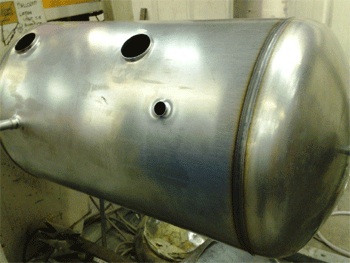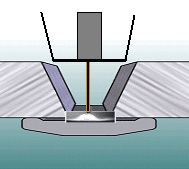Duplex Welding Applications
The TIP TIG process will provide your organization with the manual and automated capability to attain weld and clad quality levels way beyond the conventional TIG – Hot – Cold Wire TIG – Pulsed MIG and the Flux Cored process.
APPLICATION: AUTOMATED TIG ON 2205 DUPLEX INDUSTRIAL HEATING BOILERS 0.035 – 0.045 (1 – 1.2 mm) THICK.
Full penetration, defect free welds were required on these very thin gage duplex boilers shown in this photo. The traditional automated Hot / Cold Wire TIG process was used for these duplex welds. While the parts were very thin. the duplex welds were  sluggish (examine the irregular weld surface in photo). The poor weld wetting and weld irregularities influenced small pore porosity, weld fusion consistency and the weld travel rates that could be utilized. The customer typically attained a maximum Hot Wire TIG weld travel speeds from 12 – 15 inch/min.
sluggish (examine the irregular weld surface in photo). The poor weld wetting and weld irregularities influenced small pore porosity, weld fusion consistency and the weld travel rates that could be utilized. The customer typically attained a maximum Hot Wire TIG weld travel speeds from 12 – 15 inch/min.
The automated duplex tank welds were switched from Hot Wire TIG to the TIP TIG process. The TIP TIG weld parameters and speeds were achieved using an 0.035 (1mm) 2205 Duplex wire. The TIP TIG data is as follows:
- TIP TIG Weld Current : 190 Amps
- TIP TIG Weld Voltage: 12.5 Volts
- TIP TIG Travel Speed: 35 inch/min.
Watch This Duplex Welding Video
Darren the UK TIP TIG Engineer reported, “the time we had at the tank facility was limited to a few hours. I think with a more time we could develop the TIP TIG weld procedure to readily exceed 45 inch/min providing a 200% increase in weld travel. The customer stated the TIP TIG duplex welds in right photo were defect free, the welds had a superior, less sluggish weld bead appearance and the parts had a dramatic reduction in weld distortion, (note the much smaller HAZ). Also the TIP TIG process was much more stable and consistent.
You won’t be concerned with impact properties when using TIP TIG as this process produces the cleanest welds from lowest possible oxidation. The welds will have the lowest possible weld pores and inclusions and the smallest possible weld HAZ. . Our TIP TIG customers in Alberta (Cold Lake Oil Projects) reports they have never seen Duplex weld / ferrite / mechanical results as good or as consistent as those attained with TiP TiG. Many companies look to automation for their clad or weld applications. If you are considering AMET, Polysoude, CK or any automated Hot or Cold wire TIG equipment, let TIP TIG show you how a change in the process it will provide your organization with superior quality and production. You may also be interested in our low cost rotary and osscillator automated TIP TIG equipment.
 Duplex and Weld Ferrite Content: The volume percentage of ferrite present in duplex stainless steel welds will influence both the mechanical and corrosion properties. Both the duplex weld strength and stress corrosion cracking resistance may be reduced when the FN is less than 30, and there will be is a loss of duplex weld ductility and toughness when the duplex FN is above 70.
Duplex and Weld Ferrite Content: The volume percentage of ferrite present in duplex stainless steel welds will influence both the mechanical and corrosion properties. Both the duplex weld strength and stress corrosion cracking resistance may be reduced when the FN is less than 30, and there will be is a loss of duplex weld ductility and toughness when the duplex FN is above 70.
Weld shops should be aware that with both the Reverse Polarity Pulsed MIG and Flux Cored process, a small change in the weld wire stick out (common with vee groove welds) can dramatically influence the weld heat and therefore influence both the weld fusion and weld ferrite volume. With these two weld processes when used on multi-pass Vee and J groove welds, it’s always going to be difficult to fully control the weld heat.
1) With MIG and flux cored, the ferrite number in duplex pipe welds may be reduced with a decrease in wire stick out which results in a “rise in weld current, (rise in weld heat and weld dilution). That slight decrease in the wire stick out can increase the weld current in the range of 10 – 20% decreasing the Ferrite level.
2) With MIG and flux, the ferrite number increases with a decrease in welding gun angle and rise in the wire stick out. This info is
confusing but the bottom line is this. For those of you that get inconsistent ferrite readings with your MIG and flux cored welds simply remember that the gun, angles, the arc length, the weld speeds and wire stick out changes will influence the ferrite measured, In contrast, the TIP TIG process requires the welder use the correct torch angle. With TIP TIG there are no wire wire stick out changes and the TIP TIG arc length changes are miniscule. Also TIP TIG uses EN polarity which has much less weld heat impact on all alloys
